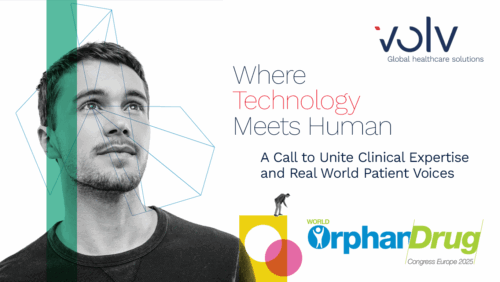By Léon Van Wouwe, Clinical Innovation Director, Volv Global
Recently, I had powerful thought come to me on reading an article about harnessing predictive modelling to overcome clinical trial enrolment challenges.
The article is not wrong.[1] It is true that, by analysing real-time data streams on clinical trial recruitment performance, researchers can identify trends and risk factors affecting enrolment. And indeed, early metrics can indicate that a particular site is underperforming due to a lack of eligible patients, at which point intervention can happen.
But in a world where we have come to expect so much in life being served to us in an instant, are we being ever more impatient and unrealistic, chasing after the quick wins without understanding the wider issue, and setting the wrong expectations?
Let me put this first: I strongly believe in the power of data-driven insights in patient enrolment. Having worked in pharma clinical development and clinical operations roles for decades, I know first hand, the feeling of despair, the stress, the anxiety of trial recruitment falling behind expectations. It was this experience, and how I saw data-driven insights not quite solving for underlying issues, that had me take a side-step, to look at the problem from a different angle.
Optimising strategy through predictive intelligence?
Optimising strategy through predictive intelligence the way the article, may be more complicated. And analytics used in that way, to respond to the challenges of trial recruitment, may not be how we can solve the underlying issues at the root of recruitment issues. Worse, it may well set expectations that none of us involved in clinical development functions can meet. And this can cost some individuals their jobs, despite their best efforts to make their clinical trials a success. I will explain why I think this.
What is early? What is quick?
The first flaw in thinking traditional analysis of real-time data streams on clinical trial recruitment performance will lead to early and quick interventions harks back to simple maths and statistics that force us to acknowledge that both “early” and “quick” are in fact qualitative statements.
I have led global development operations efforts across a raft of haematological oncology indications. The realistic enrolment rate was one patient per site, per year. Sometimes less. At that rate, if a site has not enrolled their first patient after being open for recruitment for 12 months, then that is hardly an outlier.
Sure enough, the aggregate numbers, across a large number of actively enrolling sites will add more meaning to the analysis. But anyone who has worked “the shop floor” knows it might take considerable time before enough sites have been open for long enough to get meaningful performance metrics, let alone the type of insights needed to inform a corrective action plan.
So, quick may not be quick. And early not so early.
Strategy or tactics?
The other thing that bothers me is how often tactics are sold for strategy. I am going to be blunt about that here: real time performance metrics, in the context of the article [1], do not directly inform strategy. At least not the original strategy for the ongoing project.
Rolling performance metrics inform the tactics, the actions that will influence the immediate course of the project. They can inform you of what to do to mitigate – or recover – from risks. Or how you can even improve further on what appears to already be going well.
Again, to be fair to the article, there is reference to taking on board historical site performance metrics which can be used to strategically inform the operational plan. But, more often than not, the type of study, with the target patient population further narrowed down by a myriad of inclusion and exclusion criteria, makes it hard to predict well from one study to the next.
The root problem: why many trials fail to enrol or worse.
In my experience, there seems to be one fundamental problem that is the root of most clinical trial enrolment challenges. And that is: not knowing real-world patients well enough.
In fact, not knowing real-world patients well enough, undermines not only the operational plan, including recruitment timelines, but it also puts at risk the clinical development effort itself: a common cause for failing to meet the primary endpoint is often an unexpected variability in the patients recruited into the study. A variability that only becomes obvious when data scientists and statisticians are trying to unpick the unfortunate results in subgroup analysis.
So, instead of using predictive intelligence for monitoring past and present performance of study sites, what if we generated predictive intelligence on real world patients first?
Optimising strategy through a different kind of predictive intelligence approach.
What if we use predictive intelligence on large scale real world medical data, in order to understand patients much better than we often do at the start of a clinical development program?
What if we can grasp the subtly different patient subtypes and appreciate how they are different from each other at the point of study initiation? What if we use predictive analytics on large scale real world health data, to map out real patient journeys, their actual clinical touch-points, in a lot more detail? What if we use machine learning to generate new insights from that data and to reveal the subtle signs and symptoms that we had not noticed before? What if we use artificial intelligence to work out the gaps in care we did not even realise were there?
What if we did all of that, not from what we already think we know and is published in medical literature textbooks – but from the real-world data actually on record? Because we often think we know … and then get it wrong.
A new era in predictive intelligence.
The good news is, we can! We have entered a new era of predictive intelligence, where advanced machine learning techniques can be leveraged to discover much new information about patients with disease, predicting even those that have not been (correctly) diagnosed yet, and which healthcare providers and specialists they are seeing along the way, along their patient journey. But also, understand what characterises their condition in much more detail than we ever could before, revealing subtle differences, predicting subgroups that are more or less likely to experience specific outcomes, or have faster disease progression. Including the clinical touchpoints.
Predictive modelling to help increase clinical success rates and overcome enrolment challenges
The wealth of net-new knowledge and insights about the disease can take clinical development strategy to a whole new level. Concretely then, how can – or, better – how does this new capability area of predictive modelling already help increase clinical success rates and overcome enrolment challenges?
Well, for starters, using AI to advance human understanding changes the goalposts for patient outcomes by focussing in on new, earlier signs and symptoms of disease as clinical endpoints. By narrowing down on more clearly defined and better understood patient profiles, we can increase the odds of clinical success.
At the same time, we can realise operational efficiencies by tapping into hidden populations that can be unlocked as untapped enrolment potential. Finding, within the clinical systems, patients that have thus far gone unnoticed and under the radar. Patients that are perhaps undiagnosed, or living with uncontrolled disease. And highlighting these patients to healthcare practitioners for attention, for inclusion into clinical trials.
So, let us use predictive modelling properly: up-front, when developing trial strategy, and when designing clinical development and operations plans.
About the author
Léon van Wouwe has 20+ years’ global experience in clinical development and operations, uniting data science with pharma and research. He drives cross-functional collaboration to advance innovative treatments.
References
- Clinical Leader, (2025) Harnessing predictive modeling to overcome clinical trial enrollment challenges. CSSi – An Elixia Company, 28 February. Available at: https://www.clinicalleader.com/doc/harnessing-predictive-modeling-to-overcome-clinical-trial-enrollment-challenges-0001 (Accessed: 21 August 2025).
Links:










